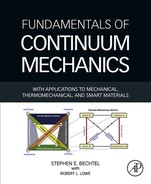Index
A
Note: Page numbers followed by f indicate figures and t indicate tables.
Archimedes' principle 202–203
Axial vector 43–44
B
Blatz-Ko model 194
C
curl 56
dyadic product 34
fourth-order tensor 47–48
indicial notation 25
second-order tensor 31–32
summation convention 12–31
third-order tensor 47–48
Cauchy deformation tensor 89–91
Chain rule 52–53
density, referential and spatial 260–262
Chu model 279
restrictions imposed on constitutive equations 148–149
nonlinear elastic materials 183–186
thermo-electro-magneto-elastic materials 285–291
viscous fluids 207–208
Conservation laws 117
angular momentum See (Balance of angular momentum)
energy See (First law of thermodynamics)
linear momentum See (Balance of linear momentum)
Constitutive equations 216–217
definition 283–284
elastic solids, large deformation 284–285
elastic solids, small deformation 296–299
definition 158
inviscid fluids 205
Newtonian fluids 200–201
nonlinear elastic solids 194–195
restrictions on 159–161
definition 175–178
inviscid fluids 212
Newtonian fluids 209–211
nonlinear elastic solids 191–193
restrictions on 178–179
incompressibility 227–229
isentropic incompressibility 235–236
isothermal incompressibility 234–235
isentropic incompressibility 232–233
isothermal incompressibility 229–232
motion-entropy, general 217–218
motion-temperature, general 216–217
Continuum 3
Couette flow 226
Curl 52–53
magnetization 264–265
physical components 63–67
Christoffel symbols 65–68
tensor divergence 70–72
D
Deformation gradient 101–103
in present configuration 115–116
in reference configuration 115–116
material 75–78
referential (Lagrangian) 75–78
spatial (Eulerian) 75–78
Determinant 36
Direct notation 5
Discrete 3
Cartesian component form 83
material description 77–78
referential description 77–78
spatial description 78
E
definition 261
imposed by the second law 183–186
imposed by invariance and angular momentum 187–189
imposed by material symmetry (isotropy) 191–193
incompressible 237–240
constitutive equations 239–240
strain energy models 241–243
Electric displacement, referential and spatial 263–264
Electric field, referential and spatial 262
Electric flux 263–265
Electric permittivity 263
constitutive equations See (Thermo-electro-magneto-elastic materials)
coupling terms, electromagnetically induced 280–282
effective electromagnetic fields 261
fundamental laws 250–271
Ampère-Maxwell law 264–265
balance of angular momentum 256–257
conservation of electric charge 260–262
conservation of mass 251–252
Faraday's law 262
first law of thermodynamics 257–259
electricity 263–264
magnetism 262–263
balance of linear momentum 251–252
second law of thermodynamics 259–260
spatial and referential quantities, relations between 265–268
total stress tensor 281
Electromotive force 262
Eulerian form 269–271
Lagrangian form 275–277
definition 130–131
Equations of motion, mechanical. See Conservation laws See also mass; Balance of linear momentum; Balance of angular momentum
properties 7–10
metric space 9
normed space 9
vector space 7–9
Euler-Almansi strain tensor. See Eulerian strain tensor
F
Eulerian form 269
Lagrangian form 275
Fourth-order tensors 48
G
Green's deformation tensor 88–90
Green-Lagrange strain tensor. See Lagrangian strain tensor
H
I
Incompressibility. Elastic solids, incompressible theory and Newtonian fluids, incompressible theory
Internal constraints. See Constraint equations
application to inviscid fluids 205
application to nonlinear elastic solids 187–189
application to thermo-electro-magneto-elastic solids 293–294
comparision with material frame indifference 305
Inverse, of a tensor 39–41
mechanical theory 205
ideal fluids 205–206
perfect fluids 212–214
Irrotational motions 105
K
Kronecker delta 25
L
Left Cauchy-Green deformation tensor. See Finger deformation tensor
Levinson-Burgess model 194–195
Localization theorem 122–123
Lorentz model 278
M
Magnetic field, referential and spatial 264–265
Magnetic flux 262–263
Magnetic flux density, referential and spatial 262
Magnetization, referential and spatial 264–265
Magnetic permeability 264
Material line 109–110
Material surface 109–110
basic principles 171–174
isotropy considerations, nonlinear elastic solids 191–193
Material volume 110
Maxwell's equations. See Electrodynamics, continuum
inviscid fluids 205
nonlinear elastic materials 181–182
Navier-Stokes equations 202–204
Newtonian fluids 200–203
fundamental laws See (Equations of motion, mechanical)
Metric space 9
compressible 194–195
incompressible 241–243
N
compressible 202–204
incompressible 219–224
compressible 194–195
incompressible 241–243
mechanical theory 200–203
thermomechanical theory 209–211
definition 229
Nonlinear elasticity. See Elastic solids, nonlinear
Normed space 9
O
compressible 194–195
incompressible 242
P
Partial derivatives 48–53
Permutation symbol 42–43
Polarization, referential and spatial 260–262
Cartesian component form 98–101
present 75–78
reference 75–78
Positive definite 39
Product rule 80–83
R
Rate of deformation tensor 104–105
properties 5–7
Reference map 75–77
Residual dissipation inequality 286
Response functions. See Constitutive equations
Right Cauchy-Green deformation tensor. See Green's deformation tensor
S
Scalar triple product 43
Second law of thermodynamics. See Clausius-Duhem inequality
Skew tensor 17
Smart materials, modeling of. See Electrodynamics, continuum
Statistical model 278–279
Eulerian form 269
Lagrangian form 276
Stress power 130–131
Summation convention 26
geometric and kinematic quantities 164–168
kinetic quantities 169–171
thermal quantities 178–180
Surface element 112–114
Symmetry, of a material. See Material symmetry
T
Tangent basis vectors 60
Cartesian components 24–31
Tensor calculus 47–48
Cartesian component form 56–59
definition 229
Thermoelastic solids. See Elastic solids, nonlinear
Thermomechanical process 175–178
Thermoviscous fluids. See Viscous fluids
angular momentum requirements 293
conjugate pairs 284–285
constitutive equations 286
fundamental laws See (Electrodynamics, continuum)
reduced Clausius-Duhem inequality 284–285
residual dissipation inequality 286
fundamental laws 295–296
piezoelectric materials, specialization to 302–303
dependent variables 175
independent variables 175
thermomechanical process 176
first law of thermodynamics See (First law of thermodynamics)
Third-order tensor 47–48
Total stress tensor in electrodynamics 281
Trace 35
V
Varga model 242
Vector product 42–43
Vector space 7–9
Velocity gradient 104–105
bulk 209–211
Navier-Stokes equations 202–204
Newtonian fluids 200–203
restrictions imposed by invariance 198–199
Newtonian fluids 209–211
restrictions imposed by invariance 207–208
restrictions imposed by the second law 207–208
Vorticity vector 104
Z
Zero tensor 13
..................Content has been hidden....................
You can't read the all page of ebook, please click here login for view all page.
